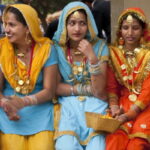We explain what otherness is and what its characteristics are. Also, the history of the concept and some examples.

What is otherness?
The otherness is the way in which a group or person perceives another as different from themselves. It is a concept used in social studies and highlights the perceived differences between “us” and “them”, where the “other” is identified as someone who does not belong to the same group, culture or community.
For the social sciences, the notion of “other” is a social construction that shows the diversity of others and highlights one's own identity. The conception of the “other/others” is constructed in parallel to the identification of the “I/us”.
The other” can generate different feelings. On the one hand, it can provoke desires or interest in what is different, what is foreign, and what we do not have. On the other hand, it can generate feelings of rejection or denial of what is different and incomprehensible.
Social attitudes towards these feelings can lead to tolerance and coexistence between various social groups, or to discrimination. In the latter case, they can generate serious problems in the community and between communities.
Key points
- Otherness is the way in which one group or person perceives another as different from themselves.
- It is a social construction that shows the diversity of others and highlights one's own identity.
- It can provoke different feelings: interest in what is different, but also rejection and denial of what is different.
Characteristics of otherness
Among the main characteristics of the concept of otherness are:
- Cultural identity. Otherness is intrinsic to the cultural identity that each social group forms to differentiate itself from the rest.
- Social construction. The concept of otherness does not describe reality, but rather highlights the importance of perceptions about others and about one's own community.
- Stereotypes. Many times, human groups construct otherness around stereotypes that concentrate negative ideas about others.
- Power relations. Throughout history, notions derived from otherness made it possible to justify relations of power and submission in terms of superiority and inferiority of different cultures.
History of otherness
Throughout history, otherness It was manifested through the ethnic and cultural differences of the different human groups. Community identities were built through a shared history, the use of language and the practice of different customs and traditions.
In ancient times, for example, the Greeks defined “barbarians” as those people who did not share their language and customs. This differentiation not only marked a cultural separation, but was also used to exalt one's own culture. The perception of others was negative and the Greeks considered their civilization to be superior to foreign ones.
In the European Middle Ages, the influence of Christianity and the power of the Catholic Church led to the construction of a notion of otherness based on religious differences. For centuries, Muslims were considered the “other” and Christian Europeans constructed negative notions of their culture.
Since the 15th century, with European expansion through Africa and Asia, stereotypical and derogatory images were created about the native peoples of those continents. Ideas of European superiority were promoted and, with them, an attempt was made to justify the colonization and exploitation of hundreds of thousands of people during the following centuries.
See also: Eurocentrism
Examples of otherness
Some examples of otherness are:
- European colonialism. European colonizers constructed a stereotypical and derogatory image of the indigenous cultures found in Africa, Asia, and the Americas. They described colonized peoples as “primitive” or “savage” to justify exploitation and domination.
- Discrimination in the United States. The history of slavery and racial segregation in the United States was built on a notion of negative otherness. Since the country's independence, access to fundamental rights and opportunities for the African-American population has been limited. Today, this remains a fundamental problem in American society.
- Cultural diversity in Bolivia. Currently, the Bolivian nation recognizes that its identity is based on the existence of different cultural groups. In this case, otherness is constructed in a positive way, as respect is promoted between indigenous communities without seeking to homogenize their differences.
References
- Campo Aráuz, AL (Ed.). (2008). Otherness. Basic Anthropology Dictionary. Abya-Yala Editions.
- Staszak, J.F. (2008). Other/otherness. International Encyclopedia of Human Geography. Elsevier.





